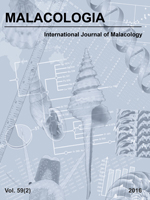The blood clam, Tegillarca granosa, is widely distributed along the coasts of the Indo-Pacific region, providing an excellent opportunity to study gene flow in sessile marine mollusks. In the present study, amplified fragment length polymorphism (AFLP) DNA markers were used to analyze the genetic structure of five blood clam populations. Genetic differentiation (Gst) and Nei's genetic distances between population pairs were found to range from 0.0245 to 0.0785 and 0.0398 to 0.1125, respectively. An AMOVA analysis showed that 89.09% of the genetic variation occurred within populations and only 10.92% occurred among populations, indicating a high degree of genetic homogeneity, probably due to considerable gene flow (average Nm = 7.1853) among populations. Cluster analysis using the unweighted pair group method average (UPGMA) showed that geographically closer populations were clustered, suggesting isolation by distance, which was further supported by a significant positive correlation between Gst and logit transformed geographic distance through a Mantel test and reduced major axis regression (r = 0.77, p < 0.05). The evident isolation by distance observed among blood clam populations along the Pacific coast of Asia is likely to be a consequence of both the passive larval dispersal carried by the South China Sea Warm Current and the genetic homogeneity caused by aquaculture-associated human activities.
How to translate text using browser tools
1 December 2016
Population Genetic Structure of the Blood Clam, Tegillarca granosa, Along the Pacific Coast of Asia: Isolation by Distance in the Sea
Yanqing Shao,
Xueliang Chai,
Guoqiang Xiao,
Jiongming Zhang,
Zhihua Lin,
Guangxu Liu
ACCESS THE FULL ARTICLE

Malacologia
Vol. 59 • No. 2
December 2016
Vol. 59 • No. 2
December 2016
AFLP
gene flow
isolation by distance
Pacific coast
Tegillarca granosa




